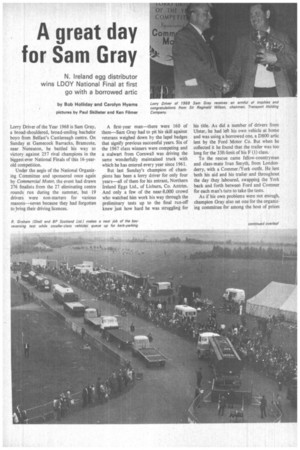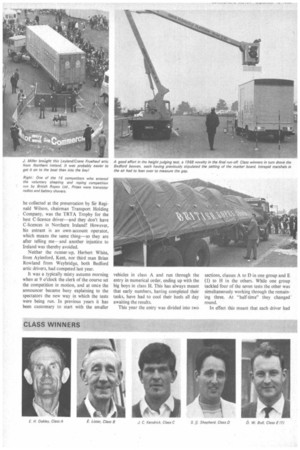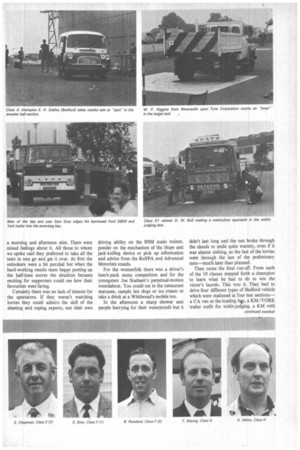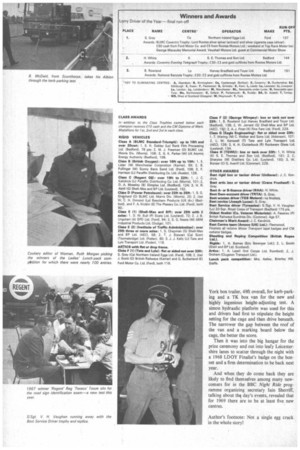A great day for Sam Gray
Page 107

Page 108

Page 109

Page 110

If you've noticed an error in this article please click here to report it so we can fix it.
N. Ireland egg distributor wins LDOY National Final at first go with a borrowed artic
by Bob Holliday and Carolyn Hyams pictures by Paul Skilleter and Ken Hinter Lorry Driver of the Year 1968 is Sam Gray, a broad-shouldered, broad-smiling bachelor boyo from Belfast's Castlereagh centre. On Sunday at Gamecock Barracks, Bramcote, near Nuneaton, he battled his way to victory against 257 rival champions in the biggest-ever National Finals of this 16-yearold competition.
Under the aegis of the National Organizing Committee and sponsored once again by Commercial Motor, the event had drawn 276 finalists from the 27 eliminating centre rounds run during the summer, but 19 drivers were non-starters for various reasons—seven because they had forgotten to bring their driving licences.
A first-year man—there were 160 of them—Sam Gray had to pit his skill against veterans weighed down by the lapel badges that signify previous successful years. Six of the 1967 class winners were competing and a stalwart from Cornwall was driving the same wonderfully maintained truck with which he has entered every year since 1961.
But last Sunday's champion of champions has been a lorry driver for only four years—all of them for his entrant, Northern Ireland Eggs Ltd., of Lisburn, Co. Antrim. And only a few of the near-8,000 crowd who watched him work his way through the preliminary tests up to the final run-off knew just how hard he was struggling for his title. As did a number of drivers from Ulster, he had left his own vehicle at home and was using a borrowed one, a D800 artic lent by the Ford Motor Co. But when be collected it he found that the trailer was too long for the 33ft-limit of his F (1) class.
To the rescue came fellow-countryman and class-mate Ivan Smyth, from Londonderry, with a Commer /York outfit. He lent both his aid and his trailer and throughout the day they laboured, swapping the York back and forth between Ford and Commer (or each man's turn to take the tests.
As if his own problems were not enough, champion Gray also set one for the organizing committee for among the host of prizes he collected at the presentation by Sir Reginald Wilson, chairman Transport Holding Company, was the TRTA Trophy for the best C-licence driver—and they don't have C-licences in Northern Ireland! However, his entrant is an own-account operator, which means the same thing—so they are after telling me—and another injustice to Ireland was thereby avoided.
Neither the runner-up, Herbert White, from Aylesford, Kent, nor third man Brian Rowland from Weybridge, both Bedford artic drivers, had competed last year.
It was a typically misty autumn morning when at 9 o'clock the clerk of the course set the competition in motion, and at once the announcer became busy explaining to the spectators the new way in which the tests were being run. In previous years it has been customary to start with the smaller
vehicles in class A and run through the entry in numerical order, ending up with the big boys in class H. This has always meant that early numbers, having completed their tasks, have had to cool their heels all day awaiting the results.
This year the entry was divided into two sections, classes A to D in one group and E (I) to H in the others. While one group tackled four of the seven tests the other was simultaneously working through the remaining three. At "half-time" they changed' round.
In effect this meant that each driver had a morning and afternoon stint. There were mixed feelings about it. All those to whom we spoke said they preferred to take all the tests in one go and get it over. At first the onlookers were a bit puzzled but when the hard-working results team began posting up the half-time scores the situation became exciting for supporters could see how their favourites were faring.
Certainly there was no lack of interest for the spectators. If they weren't watching lorries they could admire the skill of the sheeting and roping experts, test their own driving ability on the BSM static trainer, ponder on the mechanism of the Hope anti jack-knifing device or pick up information and advice from the RoSPA and Advanced Motorists stands.
For the womenfolk there was a driver's lunch-pack menu competition and for the youngsters Joe Statham's perpetual-motion roundabout. You could eat in the restaurant marquee, sample hot dogs or ice cream or take a drink at a Whitbread's mobile inn.
In the afternoon a sharp shower sent people hurrying for their waterproofs but it didn't last long and the sun broke through the clouds to smile quite warmly, even if it was almost sinking, as the last of the lorries went through the last of the preliminary tests—much later than planned.
Then came the final run-off. From each of the 10 classes stepped forth a champion to learn what he had to do to win the victor's laurels. This was it. They had to drive four different types of Bedford vehicle which were stationed at four test sections— a CA van at the loading bay, a KM /YORK trailer outfit for width-judging, a KM with York box trailer, 49ft overall, for kerb-parking and a TK box van for the new and highly ingenious height-adjusting test. A simon hydraulic platform was used for this and drivers had first to stipulate the height setting for the cage and then drive beneath. The narrower the gap between the roof of the van and a marking board below the cage, the better the score.
Then it was into the big hangar for the prize ceremony and out into leafy Leicestershire lanes to scatter through the night with a 1968 LDOY Finalist's badge on the bonnet and a firm determination to be back next year.
And when they do come back they are likely to find themselves among many newcomers for in the BBC Nigla Ride programme organizing secretary lain Sherrill, talking about t4 day's events, revealed that for 1969 there are to be at least five new centres.
Author's footnote: Not a single egg crack in the whole story!




































































































































































































































































